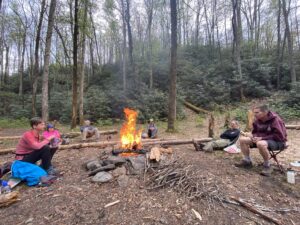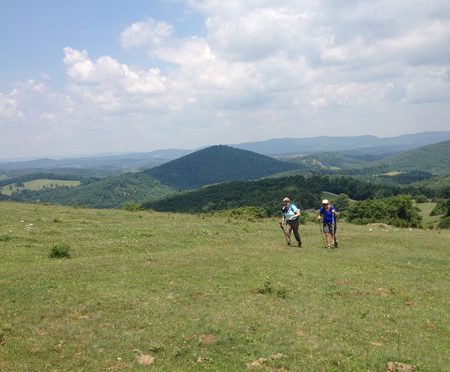You know why you haven’t gotten into backpacking?
A simple misconception.
When you think of backpacking, you likely think of hiking with 40 pounds on your back all day. In fact, you don’t. If every backpack trip we took involved lugging a full pack for days on end, we wouldn’t backpack, either.
That’s why we advocate a different approach to backpacking: Basecamp Backpacking. You hike in a short distance — typically under three miles, sometimes not even a mile — in full pack, set up camp, do day hikes — with a lightweight day pack — from there. Here are the two big advantages to basecamp backpacking:
-

Hiking, sans backpacks, at Doughton Park Backcountry camping solitude at a fraction the cost of traditional backpacking. The physical cost, that is. You’d be surprised at how short a hike it can take to achieve camping solitude. For example, one of our favorite basecamp trips is to Doughton Park along the Blue Ridge Parkway. From the Longbottom Road Access it’s a flat, mile-and-a-half hike in full pack to basecamp, a spacious backcountry site served by two creeks. From here, you have access to about 30 miles of trail for day hikes. It’s an even shorter hike — maybe a quarter mile — to the primitive site at Rock Castle Gorge in Virginia (pictured at top), from which you can day hike the popular — and challenging — 10.8-mile Rock Castle Gorge loop. Short hikes in full pack, access to miles and miles of hiking in a day pack.
- More miles, more scenery (and less aching). Most of us hike a mile and a half, maybe two miles per hour in a full pack in the mountains. After six or seven hours, we’re done. In a day pack — bearing only the 10 essentials and weighing, what, five pounds tops? — you’ll cover closer to three miles in an hour. That’s close to twice the distance based on pace alone. Then factor in the likelihood you’ll be able to hike longer with a lesser load. Who wouldn’t rather hike 15 miles as opposed to 7?
Here are some other advantages to Basecamp Backpacking:
 One home, not several. Show of hands: whose favorite part of backpacking is setting up and breaking down camp? With Basecamp Backpacking you set up camp once, you break camp once. You get a chance to settle in, to make camp feel more like home.
One home, not several. Show of hands: whose favorite part of backpacking is setting up and breaking down camp? With Basecamp Backpacking you set up camp once, you break camp once. You get a chance to settle in, to make camp feel more like home.- It’s cheaper. If your goal is to add up miles getting from point A to point B, then you’re going to quickly become obsessed with weight, and as every backpacker knows, to trim weight you have to spend more, way more. With Basecamp Backpacking, you can get away with, for instance, a $100, 5-pound tent. If you’re doing a section hike or thru hike, you’re looking at at least halving that weight, which means tripling or quadrupling the price. And that goes for every piece of equipment you have.
- Luxuries. Ask a thru-hiker what “luxury” he’s indulging and he’ll sheepishly admit to bringing a stove. This as opposed to saving the 2.6 ounces ounces his stove weights and — yech! — cold soaking. Ask me about my luxury and I’ll reply, without hesitation, it’s my Helinox Chair Zero, a camp chair that weighs in at just 17 ounces — more, likely, than the distance-hiker’s tarp tent. And frankly, I balk at referring to it as a “luxury” — it’s my dadgum right to sit comfortably around camp and I will not be denied!
- Campfire. One of the saddest things about distance hiking, in my book, is that after hiking 15 to 20 miles in one day these bedraggled distance hikers just want to eat their tepid porridge that’s been cold-soaking in a Talenti container since noon and fall asleep. I know, the campfire has been under a lot of criticism of late, but if there’s a better form of therapy out there, I’d love to hear about it. Sitting around a campfire in the evening with your people, talking about anything and everything that doesn’t have to do with work or politics or civilization is my favorite part of the backpacking experience. I love the hiking, I love nature, I’m even pretty good with inclement weather. But it’s those campfire conversations that keep me coming back.
- Don’t fret the wet. I like hiking in a light to moderate rain. What I don’t like is setting up and breaking down camp in the rain. If you’re section hiking for 10 days, that’s 20 times you need to hope it’s not raining. With a basecamp trip, it’s really only once, when you set up your one and only camp, that it needs to be dry. Set up dry and, barring an issue with your tent, you’ll stay dry.
- In fact, embrace the wet. If it rains when you return from a day hike, you’ve got a dry place to hang out and read, nap, listen to music.
- Quick bug out, if need be. If something goes wrong on a basecamp trip, you’re likely just a short hike from your car.
Backpacking has long been romanticized as the one true way to escape into the wild — but at a price. With Basecamp Backpacking, that price has dropped considerably.
* * *
Intro to Backpacking
Now that you know what backpacking can be, you’re likely wondering how you can get into it. With our GetBackpacking! Intro to Backpacking class. And the next class begins March 16. Here’s how it works:
Session 1: Getting to know you, getting to know your gear. In this Zoom session we’ll spend a few minutes getting to know one another and learning why you’re interested in backpacking. Then, we’ll go over the different types of gear, focusing on good options for beginners. 1 hour. Wednesday, March 15, 6 p.m.
Session 2: Training Day. In full gear, we will meet at Morrow Mountain State Park for a 5-hour training session that will go over: Evaluating a campsite, setting up camp, breaking camp, meal preparation (including the various food and cooking options on the trail), and more. Expect to hike about 4 miles in full pack, during which we will work on hiking technique (including the use of trekking poles); ensuring a good pack fit by adjusting your pack during the hike to make sure it continues to fit; and more. Saturday, March 18, 10 a.m.-3 p.m.
* Graduation hike. Three-day, two-night trip to South Mountains State Park, a great place for your first trip. Friday, April 14, 2 p.m. thru Sunday, April 16, 1 p.m.
Learn more and register to join us here.
Next week
Next week we share some of our favorite spots to Basecamp Backpack.
